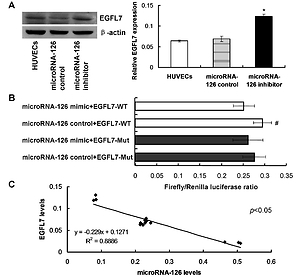Current issue
Archive
Manuscripts accepted
About the Journal
Editorial office
Editorial board
Section Editors
Abstracting and indexing
Subscription
Contact
Ethical standards and procedures
Most read articles
Instructions for authors
Article Processing Charge (APC)
Regulations of paying article processing charge (APC)
ATHEROSCLEROSIS / RESEARCH PAPER
MicroRNA-126 modulates angiogenesis and tube formation through enhancing epidermal growth factor-like domain 7 expression and phosphorylating PI3K/AKT signaling pathway
1
Department of Neurosurgery, The Second Affiliated Hospital of Hainan Medical University, China
2
Department of Neurology, Haikou Municipal People’s Hospital, China
Submission date: 2020-06-24
Final revision date: 2020-08-13
Acceptance date: 2020-08-30
Online publication date: 2021-04-30
Corresponding author
Qiang Li
Department of Neurosurgery, The Second Affiliated Hospital of Hainan Medical University, Haikou, China
Department of Neurosurgery, The Second Affiliated Hospital of Hainan Medical University, Haikou, China
KEYWORDS
angiogenesisPI3K/AKt signaling pathwaymicroRNA-126epidermal growth factor-like domain 7formation of tube
TOPICS
ABSTRACT
Introduction:
Dysregulated angiogenesis is a critical characteristic for endothelial dysfunction disorders. This study aimed to determine functions of microRNA-126 in formation of tube and investigated the potential mechanisms.
Material and methods:
The synthesized microRNA-126 control and microRNA-126 inhibitor plasmids were transfected into human umbilical-vein endothelial cells (HUVECs) using lipofectamine 2000 reagent. Cell counting kit-8 (CCK-8) was employed to measure proliferative capability of HUVECs. Transwell analysis was used to evaluate HUVECs invasive ability. Real time PCR (RT-PCR) was utilized to access epidermal growth factor-like domain 7 (EGFL7) and microRNA-126 mRNA transcription. Tube-forming capability in HUVECs was determined. Dual-luciferase assay and linear-regression analysis were conducted to measure interaction between EGFL7 and microRNA-126 molecule. Phosphoinositide-3-kinase/protein kinase-B (PI3K/AKT) signaling pathway associated molecules were evaluated using western blot assay.
Results:
Silencing of microRNA-126 significantly enhanced proliferative capability and invasive ability of HUVECs compared to those of microRNA-126 control group (p<0.05). microRNA-126 silencing remarkably promoted tube formation and significantly up-regulated EGFL7 compared to those of microRNA-126 control group (p<0.05). microRNA-126 could interact with EGFL7 molecule. microRNA-126 was also negatively correlated with EGFL7 molecule in HUVECs (p<0.05). Silencing of microRNA-126 significantly enhanced p-PI3K/PI3K ratio compared to that of microRNA-126 control group (p<0.05). microRNA-126 silencing also remarkably increased p-AKT/AKT ratio compared to that of microRNA-126 control group (p<0.05).
Conclusions:
microRNA-126 modulated angiogenesis and tube formation through increasing EGFL7 expression and phosphorylating PI3K/AKT signaling pathway.
Dysregulated angiogenesis is a critical characteristic for endothelial dysfunction disorders. This study aimed to determine functions of microRNA-126 in formation of tube and investigated the potential mechanisms.
Material and methods:
The synthesized microRNA-126 control and microRNA-126 inhibitor plasmids were transfected into human umbilical-vein endothelial cells (HUVECs) using lipofectamine 2000 reagent. Cell counting kit-8 (CCK-8) was employed to measure proliferative capability of HUVECs. Transwell analysis was used to evaluate HUVECs invasive ability. Real time PCR (RT-PCR) was utilized to access epidermal growth factor-like domain 7 (EGFL7) and microRNA-126 mRNA transcription. Tube-forming capability in HUVECs was determined. Dual-luciferase assay and linear-regression analysis were conducted to measure interaction between EGFL7 and microRNA-126 molecule. Phosphoinositide-3-kinase/protein kinase-B (PI3K/AKT) signaling pathway associated molecules were evaluated using western blot assay.
Results:
Silencing of microRNA-126 significantly enhanced proliferative capability and invasive ability of HUVECs compared to those of microRNA-126 control group (p<0.05). microRNA-126 silencing remarkably promoted tube formation and significantly up-regulated EGFL7 compared to those of microRNA-126 control group (p<0.05). microRNA-126 could interact with EGFL7 molecule. microRNA-126 was also negatively correlated with EGFL7 molecule in HUVECs (p<0.05). Silencing of microRNA-126 significantly enhanced p-PI3K/PI3K ratio compared to that of microRNA-126 control group (p<0.05). microRNA-126 silencing also remarkably increased p-AKT/AKT ratio compared to that of microRNA-126 control group (p<0.05).
Conclusions:
microRNA-126 modulated angiogenesis and tube formation through increasing EGFL7 expression and phosphorylating PI3K/AKT signaling pathway.
Share
RELATED ARTICLE
We process personal data collected when visiting the website. The function of obtaining information about users and their behavior is carried out by voluntarily entered information in forms and saving cookies in end devices. Data, including cookies, are used to provide services, improve the user experience and to analyze the traffic in accordance with the Privacy policy. Data are also collected and processed by Google Analytics tool (more).
You can change cookies settings in your browser. Restricted use of cookies in the browser configuration may affect some functionalities of the website.
You can change cookies settings in your browser. Restricted use of cookies in the browser configuration may affect some functionalities of the website.



